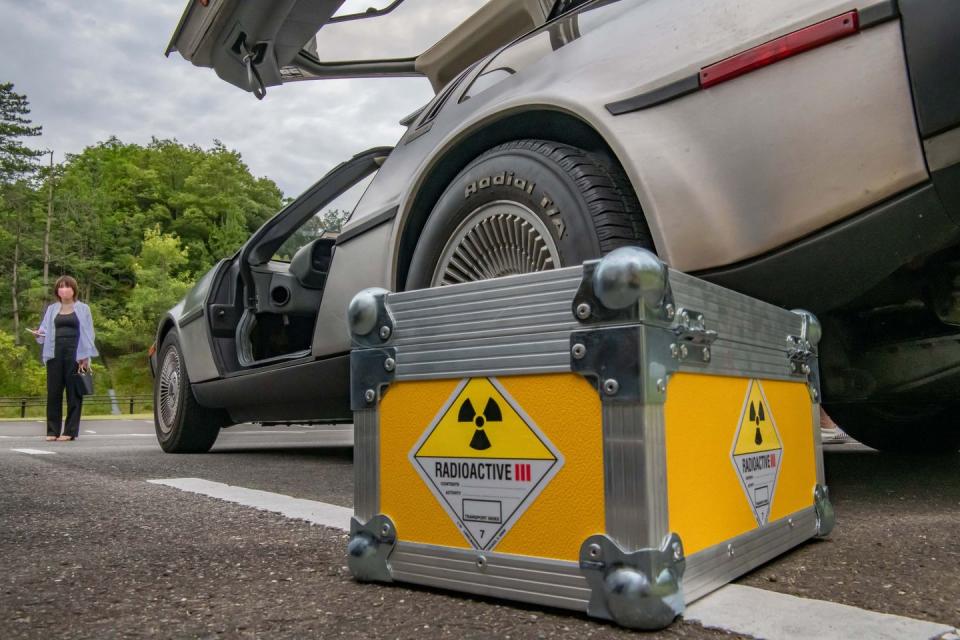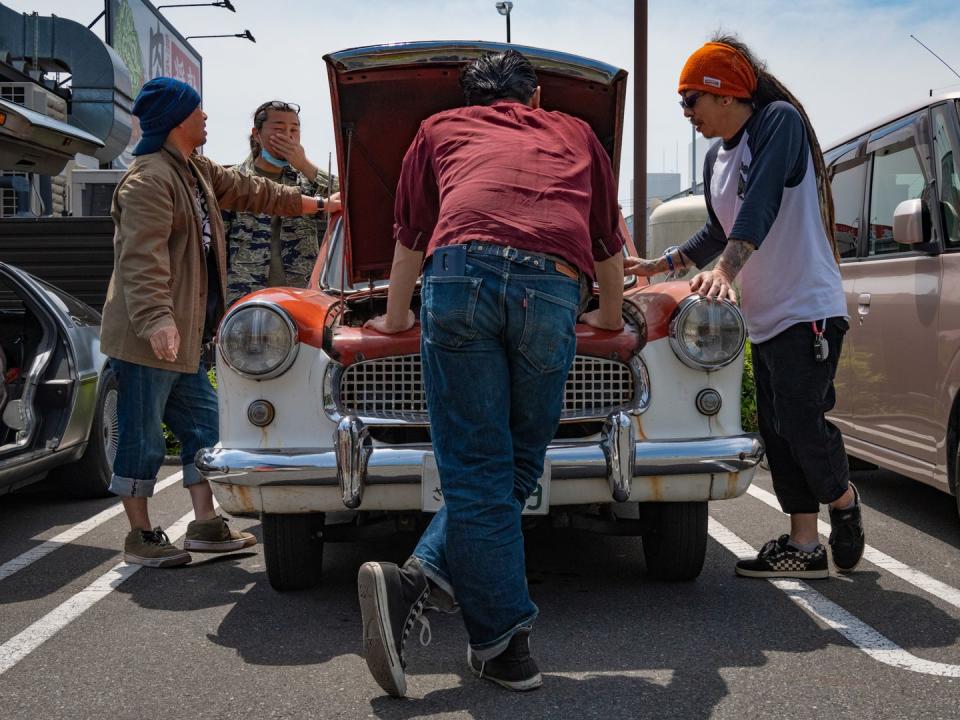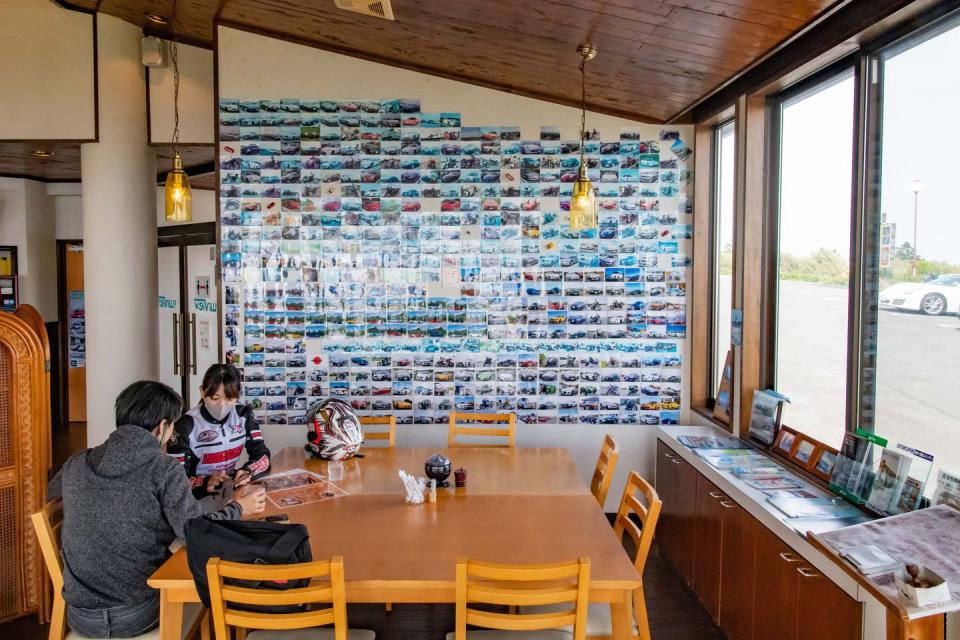How DeLorean Earned a Tiny but Vibrant Following in Japan

“I named my daughter Eleanor. After the Mustang.”
Perhaps I had misheard the Japanese gentleman beside me. It had been an early start to the morning; the Tsutaya Book Store’s monthly car cruise in Tokyo’s trendy Daikanyama district had just opened after a long, pandemic-induced hiatus, and I had not expected to hear English.
There was a collective joy among all attendees, thanks to this semi-return to normalcy, along with excitement at seeing Tokyo’s automotive gems emerge from their hiding places. I had been in search of coffee when I was suddenly bedazzled by sunlight on brushed stainless steel. A DeLorean DMC-12, gullwings spread in the morning sun. Dumbfounded by the unexpected DeLorean, and a lack of caffeine, I hadn’t noticed the owner approach.
Recovering a bit, I responded, confused. “Your daughter is named after Nicholas Cage’s Mustang?”
I sensed a frown form under his protective mask as he vigorously shook his head.
“No!” he said. “The original 1974 Gone in 60 Seconds, of course! The H.B. Halicki film was the best.” He then told me how he’d once bought a 1973 Ford Mustang Mach I, yellow with a 351 Cleveland motor, 2 barrel carburetor, and FMX transmission.
I was now completely awake. Vintage Mustangs were my first love. My earliest automotive memories were of my parents’ British racing green 1964-1/2 2+2 fastback. I can still hear its sound. Unfortunately, young love ended in heartbreak when it was traded for a brown ‘74 Pinto. A Seventies-era Mach I had recently made an appearance in my Tokyo neighborhood, so I asked if he still owned it.
“No,” he said. “I already had my first DeLorean and soon learned that I could not afford to own two sports cars, so I sold the Mach I.”
Still uncertain that I had heard his daughter’s name correctly, I sought confirmation. “Yes, I loved the car and named my daughter Erena [エレナ Japanized version, the R pronounced with L sound]. She is now 27 years old.”
The gentleman’s name was Osamu Shimohara, and our chance meeting would result in an unexpected summer tour of Japan and its diverse car culture.

DeLoreans in Japan
Our conversation turned to his DMC-12, and he told me that he has owned at least one DeLorean throughout the past 27 years.
“I bought one when I lived in Italy, so I had two at one point,” Shimohara-san shared. We both admired his car; the 40-year old design was at home among the variety of classics and the newer, far more expensive supercars scattered around the lot. I learned that he had recently retrieved the car from the shop after an engine rebuild. I recall that the original Peugeot-Renault-Volvo 2.85-liter V-6 engine left the cars underpowered, so I asked if the shop added any horsepower. Shimohara-san shook his head.
“In Japan, you can’t drive faster than 120 km/h [around 75 mph], so it’s fine. And the engine has been very reliable.”
I poked my head under a gullwing and saw that it had a 5-speed manual and a lightly worn grey interior. The dashboard evoked a wave of nostalgia. Over my shoulder, Shimohara-san told me it's been surprisingly practical.
“There are multiple storage spaces,” he says. “I have used the original rack option for a snowboard and have even taken it camping.”

The DeLorean Motor Company manufactured the DMC-12 in Belfast, Ireland from 1981 to 1982, with the U.S. as their sole export market outside of Europe. They must be extremely rare here in Japan. I ask if Shimohara-san if he knows of any others.
“Oh, there are over 100 in Japan, maybe as many as 200. A few more are imported each year.” That seemed optimistic and I was curious how he knew. “I’m the president of the DeLorean Owners Club of Japan,” Shimohara-san says.
Shimohara-san founded the club in 1994 after buying his first DeLorean. At the time, Japanese DeLorean owners struggled to find the technical support and replacement parts needed to maintain their cars. Shimohara-san established a website that connected members, shared information, and facilitated owner meet-ups. He also helped translate technical articles and books into Japanese, including James Espey’s DeLorean Buyers Guide. There are now two primary companies that import DMC-12s into Japan, DMC-Japan and Area Ten One, with some owners acquiring and importing cars on their own. Shimohara-san tells me that Area Ten One imports about one DeLorean per year, a process which typically takes one or two months. Demand for DeLoreans has grown in Japan, with younger buyers entering the market. He observed that three owners at the last meet were all in their Twenties.
We surmised that Back to the Future continues to account for some of the popularity with Gen X-ers, but what motivates younger Japanese enthusiasts? My own teenagers are reluctant to watch any science fiction that doesn’t involve CGI.
Shimohara-san then makes a suggestion. “We have meets planned this year to celebrate the DeLorean’s 40th birthday. You should join us and ask the younger owners.” I could only smile.

Back to the Future Effect?
Back to the Future is an extremely popular movie series in Japan. A subtitled version of the original film hit Japanese theaters in December 1985 and became the No. 1 Western film in 1986. A few years later there was a resurgence in the movie’s popularity when a beloved Japanese-dubbed version aired on network television. Late last year, I saw commercials for a rebroadcast of this version, celebrating the movie’s 35th anniversary. The franchise had such a sustained following that Universal Studios Japan retained their very popular BTTF ride until 2016, nearly a decade after similar rides were phased out of the Florida and California parks. I’ve also read about a technical school in Wakayama that erected a DeLorean time machine at their front entrance.
Why was BTTF so popular in Japan? First of all, the original movie was great. But the series also contains many references to Japan’s dominance in the consumer goods space at the time. Marty’s watch was a Casio, for example, and Doc’s stopwatches were made by Seiko and Citizen. The movie’s second most famous vehicle, Marty’s dream truck, was a 1985 Toyota SR5 (50 Series Hilux in Japan), although my AMC Japan friends argue that it’s upstaged by the Eagle wagon Jennifer’s father drove. And then, of course, there's Marty’s quip in BTTF 3: “What do you mean, Doc? All the best stuff is made in Japan.” All of these elements resonated with Japanese audiences and likely contribute to Japan being the home of Asia’s largest concentration of DeLoreans.
But does a 36-year old movie really strike a chord with a 20-something Japanese enthusiast? Even the Wakayama school’s time machine had middle-aged influencers behind the scenes.

Sunday Meets
Shimohara-san and I reconnected a couple of weeks later at an all-American car gathering southwest of Tokyo where, one Sunday a month, an unusual assortment of American cars takes over a McDonald’s parking lot in Atsugi. I proceed slowly down unfamiliar streets until I spot a bright orange 1957 Chevy delivery van. This must be the place. Driving past a black 1965 Chevelle and a ratted Fleetmaster, I spot Shimohara-san’s DMC-12 parked next to a 1965 Nash Metropolitan.
After a short greeting and a few introductions to various car owners, we discuss the day’s schedule over coffee. The DeLorean Club has planned a private gathering at the Tsuzuki Park Area later that morning, part of a larger gathering organized by the Isuzu Piazza owners club. Sensing my puzzlement, Shimohara-san tells me that the cars are actually cousins; both cars were drawn up by the famous Italian designer, Giorgetto Giugiaro. Additionally, the Piazza's first model year in Japan was 1981, so both cars celebrate their 40th birthdays in 2021. The respective auto clubs decided to hold a few joint events this year in recognition.

I follow Shimohara-san’s DeLorean into the highway parking area, where another DMC-12 is parked next to a line of Isuzus. The Piazza, more familiar to American enthusiasts as the 1983-and-up Isuzu Impulse, is a sporty 2.0-liter 4-cylinder rear-wheel-drive wedge with a slight family resemblance to the DeLorean, especially in the nose.
As I walk toward a black-trimmed 1981 DeLorean, I’m greeted by Peter Xu, the owner. The twentysomething now commutes to work in Tokyo by train, so his car doesn't need to be a daily driver. As we check out his ride, he tells me the DeLorean’s analog nature is a big part of the car’s appeal for him.
“I like to tinker, and the car provides a great platform that new cars don’t offer,” Xu says. He’s done a lot of tinkering, primarily to improve reliability and performance. He's replaced the throttle body, fuel and vacuum lines, and antique relays. He’s also installed a new aluminum radiator, lowering springs, shocks, and billet control arms.
“Watch this,” Xu says, pressing a button on a fob. The driver’s side gullwing slowly rises and I peek inside. Mounted behind the driver is what I believe to be a cosmetic addition: A small flux capacitor. I ask Mr. Xu if BTTF sparked his interest in the DeLorean.
“Not really,” he says, casually. “ I first saw the car playing Gran Turismo.” He thought the car looked cool, despite its poor in-game performance, and sought out all the info he could find. He’s since seen the movie.
Xu asks where I first saw a DeLorean. When I share a memory of seeing a then-new DMC-12 on the road in the early Eighties, his eyes widen in disbelief.
“Wow,” he says. “That was a long time ago!”
I decide that it’s time to go.

Fuji View
A few weeks later, the DeLorean and Piazza clubs met again on the Ashinoko Skyline, high in the mountain region of Hakone. The mountain road is close to both Mt. Fuji and the Anest Iwata Turnpike, better known as Japan's Nürburgring. It was a beautiful morning, so my daughter decided to tag along for a twisty hill-climb drive up to the spectacular views from Fuji View Rest House. We pass six DeLoreans and two dozen Piazzas as we enter the parking lot to grab brunch.
Automotive mementos line the walls of the Rest House’s interior. Hundreds of photos fill a large pinboard on one wall, a record of JDM and international classics that made the pilgrimage to their lot. After devouring two heavenly bowls of lemon ramen, we mingled with the DeLorean owners. Most club members we spoke with prefer to keep their DMC-12s stock, adding only small accents to personalize them. One owner, a man named Mimori-san, has added a resin shift knob containing a dried flower.
“It is called a suichuuka," he tells us—loosely translated, flower inside of water. “It became a popular car accessory in Japan during the Eighties.”
We move on to the DeLorean owned by Kosuke Hashimoto, another purist. Hashimoto-san is a young owner and works in technology for a gaming company.
“Everyone here has added navigation, but I have not,” Hashimoto-san says. “Even the audio system is original.” I can’t help but note that Hashimoto-san is wearing a 35th Anniversary BTTF shirt and I ask if the movie sparked his interest. His laugh and smile are my answer.

Toyota Automotive Museum
The Toyota Automotive Museum in Aichi is one of the best in the world. Their collection is not limited to Toyota or Japanese vehicles; it offers a world history of the automobile, but its collection of Japan’s important domestic cars makes it quite special. When I received a note from Shimohara-san telling me that the club had planned a large regional event at the museum, I jumped at the opportunity to join.
Heavy gray clouds hung over my drive to Aichi. Upon arriving, I see nearly a dozen DeLoreans lining the designated parking area. A Japanese car magazine rushes to interview owners and take photos before it rains. I see familiar faces in the crowd, including Shimohara-san, Hashimoto-san, and Peter Xu. While most of the other attending club members are over 40, I note two younger men working rapidly on their car. One of the men has attached a Mr. Fusion Home Energy Reactor while the other works to fasten on time machine exhausts.

“They are engineers,” Xu informs me. “They fashioned those exhausts from aircraft-grade aluminum.”
Young Japanese enthusiasts appreciate the camaraderie and egalitarian nature of the DeLorean Owners Club, which ties to a global group with common interests. The younger owners also like the attention that the DeLorean’s timeless looks and pop-culture association attract.
“It's a dream to own a car that I've loved since I was a kid,” Shimohara-san says. “A dream that can be realized because it can be purchased and easily maintained.”
It appears that the young enthusiasts in an aging Japan share this dream. This points to a bright future for the 40-year old DeLorean DMC-12, a car that took me on an automotive journey through Japan’s present and past.
You Might Also Like

 Yahoo Movies
Yahoo Movies 
